|
|
Marititime Topics on Stamps
|
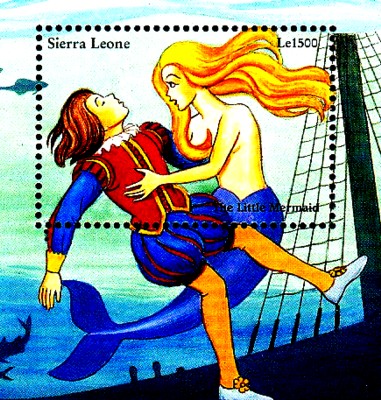
Of Mermaiden and Nixies.
|
|
Mermaids, water nymphs, sirens, and nixies, are among the prittiest female beings.
Of course they have long black or green hair, noble formed faces and well rounded breasts.
However, from the waste on downwards, they have nothing but a scaly fishtail!
|
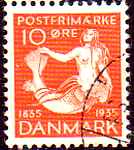
|
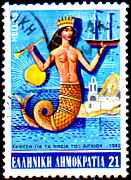
|
Mermaids are very popular with the Scottish. If you don't insult them, they will turn mishap away from you.
They can also look into the future and forecast upcoming storms.
If you annoy them or make fun of them, they turn their faces to the ship and dive down.
And then calamities and disaster will follow one another.
However if they turn their faces away from the ship when diving under, the ship will have a lucky voyage.
|
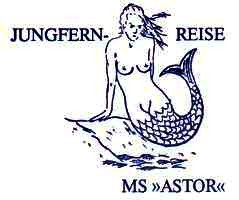
|
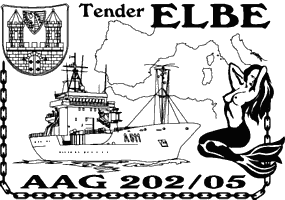
| |
The first regular voyage of a newly built boat we call its virgin voyage (German: Jungfern Reise) . On letter cachets
with mermaids on them are very popular, as shown here with the MS "Astor" and the navy tender "Elbe".
|
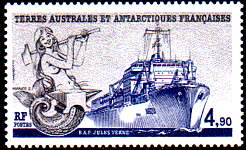
|

|
On the stamp on the left hand side, next to the polar boat "Jules Verne" we find a mermaid raising a hammer,
holding an anvil with her tail. A hard beating will hit upon it.
On the right hand side the mermaid holds a Japanese submarine caringly in her arms. There you would want to be hired!
|
|
They say, that the sailors on the old sailboats did actually fear the mermaids. A certain shyness against female beings
may have played a role in such superstitions. It has been reported, that several centuries ago, when a mermaid tried to
climb a Hamburgian sailing vessel, the sailors beat on her with sticks, until she gave up weeping bitterly and sinking
back into the water.
|

|
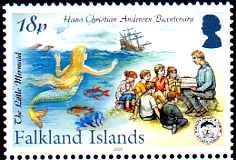
|
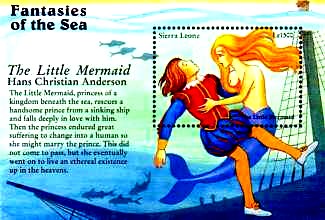
|
One of the most widely known fairy tales of the Danish writer Hans - Christian Andersen is his "Little Mermaid".
The most beautiful little virgin mermaid is only 15 years of age, as she is allowed for the first time to swim up to the
water surface and look around. She encounters a boat with a prince on board, and falls in love instantly.
As it happens a wild storm sinks the boat, a heavy beam hits the prince and he looses his conscious.
The little mermaid saves his life and takes him to the shore. Ashamed of her fish tail she hides nearby.
Another girl discovers the sleeping prince and takes him to the king's palace.
|
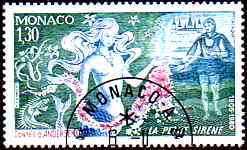
|
In her great love the little mermaid desires to become human. She meets a witch who gives her a magic potion,
which splits her tail and becomes two human legs. However the price is high: she must give her voice to the witch in
return and can no longer speak.
The prince takes her to his court, but marries the girl, who found him on the beach. The poor little speechless
mermaid in her hopeless desperation jumps into the water and becomes foam.
|
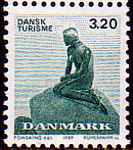
|
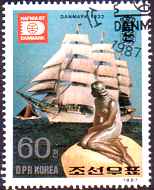
|
The Danish sculptor Edvard Eriksen made a bronze statue of her, and she sits on a rock at the inlet to the harbor of
Kopenhagen since. She is so popular, that she became the hallmark of Kopenhagen, see also the stamps above.
Her head is shaped after the ballerina Ellen Price, the body after the wife Eline of the artist.
The sculpture was revealed in a festive ceremony on the 24th of August, 1913. It weighs 175 kg and yet is only 1,25 m high.
What you see however is a copy only. The original is kept in a secret place, since the sculpture was smeared with
paint and damaged a couple of times.
Today a walk to the "Lille Havfrue" is a must on every visit to Kopenhagen.
|
|
Nixes are water-sprites of the north-European mythology. While Nixie is the female form, there also exists the Nix,
often called "waterman," the Aquarius of the astrological zodiac. Nixies bring danger to people, impair and even death!
Quite often they delure the men and pull them down to the bottom of rivers and lakes.
Tales describe the Nixies as young women with green skin and long hair, but also as female beings with a scaly fishtail.
|
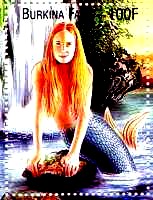
|
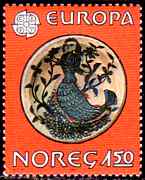
|
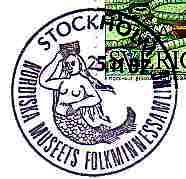
|
The "Water Woman" must be distinguished from the other female water beings, in particular from the nixies and
mermaiden. Her characteristic difference is her positive attitude to humans. Being mer-woman, she gives life,
protection and blessings. As a Mer-Bride she marries a man and gives her love to him.
Water women appear already in the myths of antique cultures. Such as the moon goddess Derceto with a fishtail in
Asia Minor, the goddess Vishnu in India, a woman with four arms and a fish lower body, and dragon women in China.
|

|
Columbus too was guided by a protecting female hand across the Atlantic ocean!
|
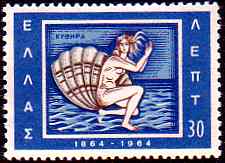
|
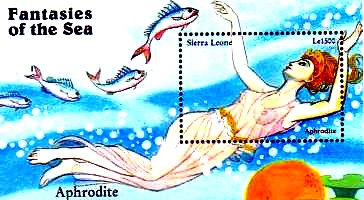
| |
All sea goddesses belong to the sea woman category. The Greek goddess of love Aphrodite,
the "foam-born", is also a sea woman, although she is shown on the two stamps without a scaled lower body.
|
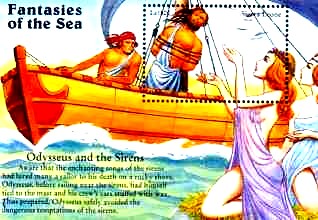
|
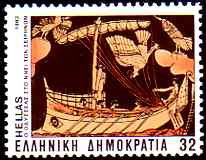
|
The sirens of the Greek mythology are female fabulous beings, originally they were thought of as blends of women and
birds, later of women and fish. Sirens allure the passing skippers in order to kill them. However, if a sailor would succeed
in passing them without giving in to their delusions, the sirens in turn would be doomed to fall into the sea and drown
themselves.
Both Orpheus and Odysseus succeeded in passing the sirens. Orpheus sang louder than the sirens,
such their singing could not be heard. Odysseus was tied to the mast by his fellow men, while they themselves
closed their own ears with wax.
|
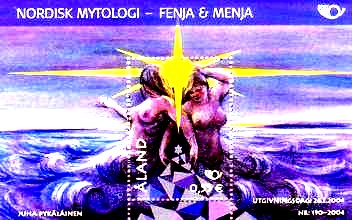
|
In the sagas of the Åland islands there are two female creatures, Fenja and Menja.
They were slaves at the kings court and had to grind gold. One day the king was attacked by a fleet of warships.
Fenja and Menja were taken on a boat and asked to grind salt. The boat sank in the battle, but Fenja and Menja
are still grinding salt on the bottom of the sea: That is why the sea water is salty.
|
|
Among several mythological variations of Lilith there is also one, describing her as a female sea monster (Leviathan)
and goddess of storms. She robbed men, who could not resist her charme.
But she was punished for her all too human excesses, her legs were chained and she was doomed to live in the
depths of the sea forever.
|
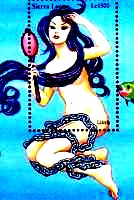
|
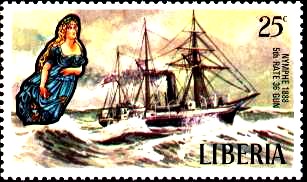
|
Nymphs are nature spirits in greek and roman myths. Nymphs were pictured as lovely lightly dressed girls.
There are numerous kinds of nymphs. Among the water nymphs the Najades (running water) are most widely known.
They had to guard springs, rivers and lakes. If the body of water, which a Najade had to care of, dried up,
she must die. However with the British cruiser "Nymphe" we have a rather well shaped figurehead.
|
|
The Nereids are the fifty daughters of Nereus with Doris. They are the Nymphs of the Mediterranean.
They protect the shipwrecked and entertain the sailors with plays. They are also accompanying the sea god Poseidon.
On many old greek pictures the nymphs ride on dolphins.
|
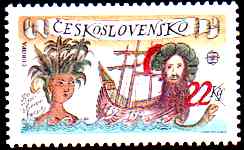
|
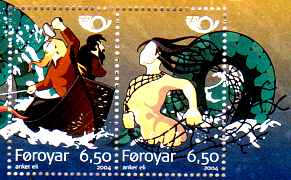
|
The Nordic world of gods as described in he Edda, includes Thor and Ran. Ran is the wife of the sea god Ägir.
On the right hand stamp Ran is searching for drowned sailors with a net. She is the mistress of the souls of the
drowned. On the left hand side Thor is swinging his hammer.
|
|
The Finnish national epos Kalevala knows Luonnotar a water-mother. She came down from the sky and was made
pregnant by the wind. After participating in the forming of the world she gave birth to the old Väinämöinen.
|
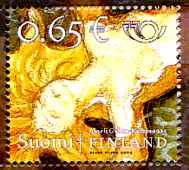
|
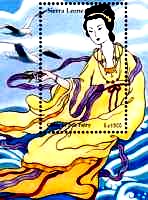
|
The Chinese myths include fairies, who can walk on waves. Indian buddhism knows that these Women or Fairies
lived in the sea.
|
Now here is a whole lock of sea goddesses of the pacific ocean.
The upper row from left to right: the snake Walutahanga of Micronesia with mother and daughter, who did not eat
from the eight parts of the snake.
Tien-Hou of China shines light with his lantern to help the sailors, and Lorop of Micronesia dives for fish.
In the lower row: Oto-Hime of Japan appears to a prince in a canoe, Nomoi of Micronesia protects a little animal,
and you surely will meet the Junkgowa sisters, if you travel the coasts of Australia.
|
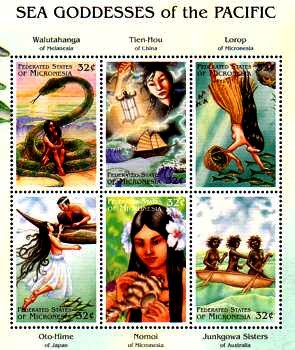
|
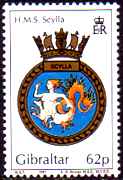
|
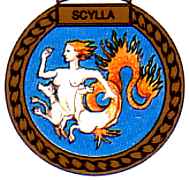
|
Scylla was sea monster of the Greek mythology. She had the upper body of a young woman, while and her lower body
was made of six dogs. Once she had been a pretty girl, a nymph ,and was in love with Glaukos.
The sorceress Circe was jealous and poisoned the sea, in which Scylla was bathing. When Scylla got out of the water,
she was disfigured and out of her lower body grew six dog heads.
Scylla became a wild beast and swore
revenge for the crime done to her. She met also with Odysseus and the Argonautes.
|
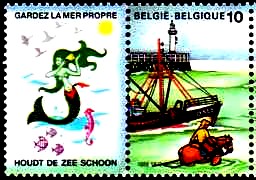
|
Undine is a female virgin water sprite, a nymph. She is immortal. However if she marries a human and gives birth to a child,
she and the child will get a soul and loose their immortality.
Undine will bring death to an unfaithful husband.
|
Melusine is a figure of the European sagas. She is shown as a woman with a lower body of a fish or snake.
The tale has it, that she agreed to marry a Scottish king, if he promised to never enter her room, when she was
either bathing or giving birth to a child. As he broke his promise, she left him together with her three daughters.
Fifteen years later the daughters took revenge and buried the king alive in a mountain.
Melusine was cursed and from the waist down turned into a snake or a fish.
|
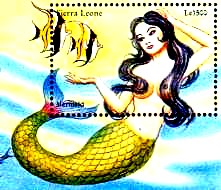
|
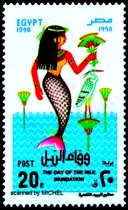
On this Egyptian stamp we have the bride of the
river Nil with a lotus flower and a heron.
|
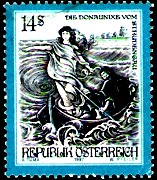
The Danube mermaid of Strundengau, an Austrian saga.
|
On this stamp is written: "a seal, which was mistaken for a mermaid." This may possibly explain many reports of mermaids.
On the Philippines a tradition exists to make artistic sea monsters out of leftovers of fish and monkeys for the tourists.
They are displayed as mummified mermaids.
|
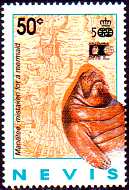
|
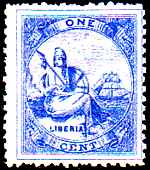
|
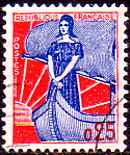
|
On the left hand side, on the Liberian stamp we see a woman, who stands for liberty (in latin it is "Liberia").
A boat too belongs to the symbols of freedom. Such allegories are found on many stamps.
A final example is the French Marianne with the Jacobian Cap in a sailboat.
Marianne also was the name of a secret republican society in France, and became alter a synonym for
the heroine of freedom. Today she is the personification of the French republic.
|
|
Sources:
Wikipedia Internet Encyclopedia
J.W. Scheutzow, ... ihre Heimat ist das Meer (Her Homeland is the Sea)
E. Wiese, Meeresungeheuer, Geisterschiffe und der Klabautermann (sea monsters, ghost ships)
|
© 1998 - 2007 Bjoern Moritz, all rights reserved.
|